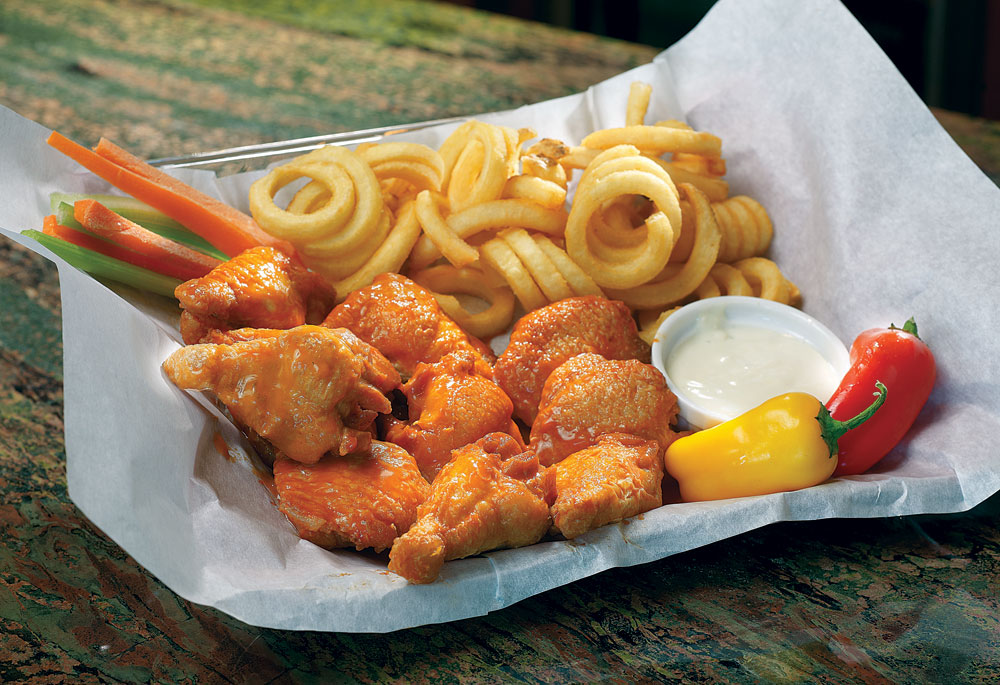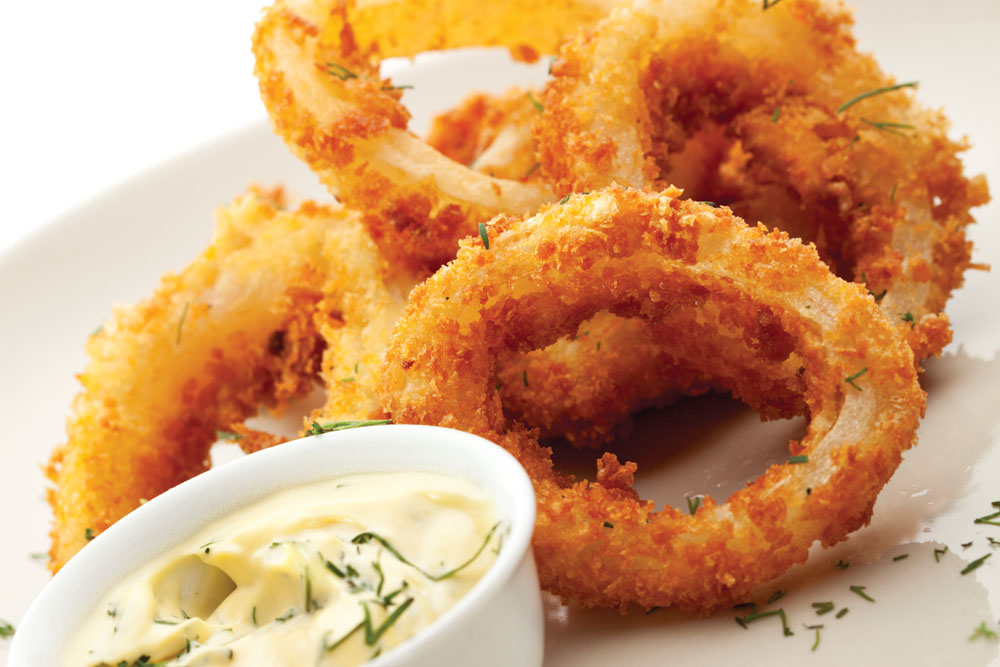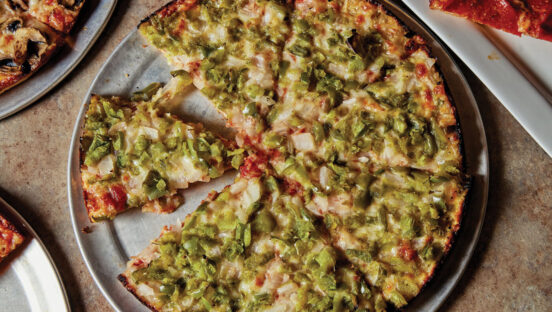Cheesy bread, mozzarella sticks, hot wings—these popular appetizers are ubiquitous on menus today. But (pardon the pun) those are just for starters. As customers’ palates become more sophisticated, many pizzerias have begun to experiment with their appetizer menus, serving up regional favorites ranging from poutine and haddock in New Hampshire to fried cheese curds in the Midwest and shrimp and gumbo on the Gulf Coast.
Most customers expect to see appetizers on a restaurant’s menu; according to a study by the food industry consulting firm Technomic, about 24% of diners order a first course. More importantly, appetizers increase average ticket sales and buy time for the kitchen staff as pizza orders stack up on busy nights. They’re also the easiest items to upsell, because guests often show up already hungry and ready to eat. Upselling starters makes for happier customers, who can enjoy more of your pizzeria’s tasty offerings, and happier servers, who make better tips off higher tabs.
A Sense of Place
It’s usually safe to stick with tried-and-true appetizer fare, but some customers prefer to add a dollop of adventure to their dining experience. That’s why Mr. Pizza (mrpizzanh.com), a family-friendly pizzeria in Gorham, New Hampshire, offers more than 30 appetizers, including sweet potato fries with warm maple syrup, fried cauliflower served with a cheese dipping sauce, and several flavors of breadsticks (such as pepperoni and Philly cheese steak), as well as a couple of items with a regional flair. According to owner LouAnne Pelkey, her unique Neptune Nibblers—fresh haddock chunks that are breaded, fried and served with tartar sauce for dipping—rank among the pizzeria’s most popular starters.
 “We sell a lot of appetizers as meals because they’re so big,” Pelkey says. “We also sell a ton of poutine, since we’re so close to the Canadian border, where it’s a national snack.” Health-conscious diners may not go for poutine—crispy French fries topped with gravy and melted cheese—but many Northeasterners love this high-calorie Québécois comfort food.
“We sell a lot of appetizers as meals because they’re so big,” Pelkey says. “We also sell a ton of poutine, since we’re so close to the Canadian border, where it’s a national snack.” Health-conscious diners may not go for poutine—crispy French fries topped with gravy and melted cheese—but many Northeasterners love this high-calorie Québécois comfort food.
Of course, appetizers, like any other food, are often influenced by regional preference. “Reuben and Philly cheese steak-type items are more popular in the Midwest, Northeast and Mid-Atlantic areas,” notes Garret Swart, owner of J.M. Garret Foods in Noblesville, Indiana. “Jalapeño poppers are great for the Southwest and the Southeast. There are flavors to fit every profile. This doesn’t mean you can’t sell something spicy in Minnesota, but you have to consider your customers’ tastes.”
Some upscale pizzerias, meanwhile, feature artisanal, made-from-scratch items to separate themselves from competitors. At Lennie’s Restaurant and Pub (lenniesgourmetpizza.com) in Bloomington, Indiana, the spinach and artichoke torta, layered with goat cheese and topped with sweet red pepper relish, is the most popular starter. “We make most everything from scratch, including our own tortilla chips and wing sauce,” says Lennie’s general manager Mike Fox. “Our chef makes his own sausage using local beef and pork from heritage breed pigs, which we serve on a German-style sausage and cheese plate.”
Combination plates are appealing to customers because they allow for a variety of tastes to satisfy a large group. According to Gene Fontanini, owner of Fontanini Meats in McCook, Illinois, sausage balls have become increasingly popular as an alternative to—or as a partner with—a platter of wings, for example. Many pizzerias already have frozen pulled sausage balls on hand as pizza toppings, so they can be tossed with a Buffalo or teriyaki sauce and heated up quickly in the oven. “They have a good, soft and meaty chew and complement appetizer combinations,” Fontanini observes. “I would feature them on a combo platter with wings, mozzarella sticks, meatball marinara or jalapeño poppers.” For a lighter appetizer, you can also put meatballs on a chopped salad, he adds.
The Deep Freeze
Some guests, of course, prefer to go with what they know they like, and frozen food items, which are quick and easy to prepare, help pizzeria operators meet that demand. “Cheese sticks, onion rings and jalapeño poppers are our most popular items,” says Deirdre Dickerson, director of corporate communications at McCain Foods in Lisle, Illinois. “Breaded and battered vegetables are growing in popularity, and many are now available in bakeable options.”
Prepared frozen appetizers save on time and labor and can be prepared in equipment you’ve already got in your kitchen. “The huge selling point is that you can prepare these products in an impingement, convection or regular oven or fry them, which gives operators an easier way to service their customers,” Swart points out.
According to Bob Nussbaum, owner of Appetizers USA in Rio Verde, Arizona, the speed and ease of frozen appetizer preparation has several advantages. “Frozen appetizers bake up fast, and they’re great for off-premise catering,” he says. “Some can be thawed and served at room temperature. Distributors can advise operators on the best ways to serve each dish and how much to include in a serving.”
Frozen appetizers have evolved from the traditional sticks and poppers. Now they include treats such as breaded banana pepper rings, battered and diced jalapeños mixed with cream cheese and bacon, and fried hot tamale sticks. “You can take an old favorite like a popper and, by changing the look and feel of it, you’ll have something new and exciting,” Swart says.
Spread Your Wings
Joey Todaro III, owner of Buffalo, New York-based La Nova Wings, helped start the chicken wing craze when he went national with his wings business in 1994. Although the price of wings has risen in recent years as the supply has diminished and demand has increased, this hasn’t dampened customers’ enthusiasm for the juicy appendages and the variety of sauces that enhance their finger-lickin’ good flavor, according to Todaro. “The more money they keep charging for the chicken, the more pizzerias have to mark up the costs, but people are still ordering them,” he says.
Part of wings’ mass appeal can be traced to the great levels of customization due to a seemingly endless variety of seasonings and sauces. “Everyone has different tastes in wings, so it is important to offer a variety of flavors to appeal to everyone,” says La Nova executive vice president Michael A. Dentico. But, for most diners, you can’t go wrong with the spicy stuff: “Heat is where it is at these days, especially with the younger generation,” he says.
Ready-to-heat frozen wings come fully prepared and sauced, or plain for the operator to add sauce later. “We have found that tossing oven-roasted wings in the sauce just prior to serving is the most desirable way to serve them,” Dentico says.
Mike Griffin, owner of Griffin’s Wing Sauce in Levittown, Pennsylvania, says that some of his pizzeria clients sell more wings than pies. “I have customers that sell 1,000 to 1,500 pounds of wings a week,” he says. And with football season in full swing, the demand for home delivery of chicken wings with pizza orders isn’t likely to abate. With that in mind, Griffin suggests skipping Styrofoam or aluminum containers to prevent sogginess. “Line a pizza box, and put them in that. The wings will stay fresh-tasting for so much longer.”
Pizzeria operators can also expand their chicken offerings to include boneless tenders, which are more readily available than wings, Dentico notes. “This way, pizzerias are prepared to serve their guests a chicken product even if they don’t have enough wings to meet the demand, especially when it comes down to crunch time, such as during the Super Bowl.”
Boneless chicken wings, which are actually made of breast meat, offer certain advantages. “You can serve four to five boneless wings and offer the same amount of meat as you’d get with 10 servings of a bone-in wing,” says Mark Matlock, senior vice president of sales for EZ Wings in Riviera Beach, Florida. “Plus, some customers don’t like messing with the bone or just don’t want to get sauce all over their hands.”
Boneless wings can be useful for recipes as well. “A good appetizer offering for a pizzeria is Buffalo wing sliders with blue cheese dressing and a choice of hot sauce or a house sauce, covered in provolone,” Matlock says.
Portion Control
So what’s the perfect portion for your appetizers? It depends on whom you’re serving. “Our clientele is looking for an appetizer that’s big enough to share,” says Meggie Lindberg, marketing manager for Lou Malnati’s (loumalnatis.com) in Chicago. “Our most popular items are wings, three-cheese bread, bruschetta and calamari. These items all have a homemade touch; they complement pizza well; and they’re easy to share and big enough to give everyone a good portion.”
But, according to research by McCain Foods, many diners respond positively to the idea of smaller appetizer servings. In one survey, 50% of guests who said they do not usually order starters said they would do so if they were available in smaller, less expensive portions (under $5). Since up to half of all casual and midscale dining visits are made by parties of two, a half-portion offering can encourage sales to these tables as well as to your bar customers. Some restaurants, especially those with bars, offer happy hour half-price appetizers to build foot traffic and boost liquor sales during quiet weekday hours.
“We do have people who are concerned about calorie intake, and generally we have large portions, so we offer a half-order on some of our appetizers for a healthier option,” Fox says. “While healthy eating is a concern for many customers, the biggest factors we see playing a part in their decisions are the value, size and taste of the item.”
Setting a Price
There are various ways to price starters, encourage sales and net a tidy profit. “Many of our appetizers are priced roughly at about half of the cost of our pizzas,” says Priscilla Lane-Rondeau, owner of 900 Degrees Neapolitan Pizzeria (900degrees.com) in Manchester, New Hampshire. “Our rustic garlic bread is priced a few dollars cheaper to appeal to customers before their pizza comes, but our Mussels Fra Diavolo and our 900 Antipasto are priced much higher due to the superior quality of the products we use. This gives us a broad spectrum of options, appealing to a wide customer range.”
Some operators offer appetizers as part of a larger deal. “They can leverage bundled promotions by adding appetizers as side options with pizza purchases,” Dickerson says. A pizza bundled with breadsticks or wings and a bottled soda can be an easy sell, especially for takeout or delivery.
And don’t forget your most effective selling tool—your menu. Tantalizing photographs of your more profitable items—or, at least, a vivid description that makes them look too good to pass up—can often sway an undecided customer. “We use strategic placement of decorative chalkboards to advertise our appetizers, along with a descriptive menu that highlights certain items with red borders to draw the customers’ eyes,” Lane-Rondeau says.
When pricing your appetizer menu, consider the real cost per serving, Swart advises. “People look at a case or per-pound price, but that’s not how you sell appetizers,” he says. “You sell them by the piece. If a product costs you $30 and there are 192 in a case, that comes to less than 16 cents each. You can charge at least $3.99, and then you’re running at 26% food cost, even if you account for dip and wax paper to serve them on.”
You should also experiment to find out which appetizers sell well and which are less popular. Dickerson recommends trying out new items before putting them on the permanent menu. “Pizzerias can offer fun, shareable appetizers as limited-time offers first,” she says. Pelkey agrees, noting that many of her pizzeria’s regular appetizer menu items started out as specials.
By treating your appetizers as an integral part of your menu rather than as an afterthought, you’ll please your regulars while bringing in diners who might not ordinarily go out for pizza. Even better, you’ll reap the benefits of higher check averages and a boost to the bottom line.
Closing the Sale
Tell, don’t ask—that’s the phrase to remember when pushing appetizers to your clientele. Waitstaff should always offer suggestions on appetizers rather than simply asking the customer, “Would you like to start out with an appetizer?” That means your servers must know and understand the menu and possess a knack for sizing up what guests might like. Making the pitch feel personal always helps, too: “Would you like an appetizer while you look over the menu?” the server might inquire. “I really like the bruschetta—it’s a delicious combination of tomatoes, mozzarella and fresh basil tossed in olive oil and topped with shaved Parmesan on toasted garlic bread.”
“We coach our staff to upsell by describing appetizers in an appealing way in terms of quality ingredients, preparation and popularity,” explains Priscilla Lane-Rondeau, owner of 900 Degrees Neapolitan Pizzeria (900degrees.com) in Manchester, New Hampshire. “Additions to appetizers, such as mozzarella melted on top of our signature meatballs, are also offered.”
Kid-friendly goodies—such as mozzarella sticks or French fries—are always good suggestions, as little ones often influence the family’s buying decisions. “Our main clientele are families, and they like to share,” says Meggie Lindberg, marketing manager for Chicago-based Lou Malnati’s (loumalnatis.com). For a large table, the server can suggest two or more items or a combination platter. If the guests look uninterested in the server’s first suggestion, he should offer a second choice. “Often people are so focused on their ‘usual’ order that they don’t even consider anything else,” Lindberg says. “Our goal is to introduce great products they might not have tried otherwise.”
At Lennie’s Restaurant and Pub (lenniesgourmetpizza.com) in Bloomington, Indiana, general manager Mike Fox lets the dishes speak for themselves. “When a server brings a hot plate of appetizers through the dining room, they intentionally carry them low so the other diners can see,” Fox says. “Once a waiter brings an order of our hot wings to a table, everyone smells them, and we immediately get three or four more orders.”















